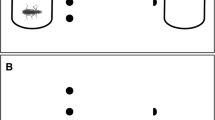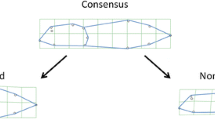Abstract
Predator-induced phenotypic plasticity is widespread among aquatic animals, however the relative contributions of behavioral and morphological shifts to reducing risk of predation remain uncertain. We tested the phenotypic plasticity of a Neotropical tadpole (Rana palmipes) in response to chemical cues from predatory Belostoma water bugs, and how phenotype affects risk of predation. Behavior, morphology, and pigmentation all were plastic, resulting in a predator-induced phenotype with lower activity, deeper tail fin and muscle, and darker pigmentation. Tadpoles in the predator cue treatment also grew more rapidly, possibly as a result of the nutrient subsidy from feeding the caged predator. For comparison to phenotypes induced in the experiment, we quantified the phenotype of tadpoles from a natural pool. Wild-caught tadpoles did not match either experimentally induced phenotype; their morphology was more similar to that produced in the control treatment, but their low swimming activity was similar to that induced by predator cues. Exposure of tadpoles from both experimental treatments and the natural pool to a free-ranging predator confirmed that predator-induced phenotypic plasticity reduces risk of predation. Risk of predation was comparable among wild-caught and predator-induced tadpoles, indicating that behavioral shifts can substantially alleviate risk in tadpoles that lack the typical suite of predator-induced morphological traits. The morphology observed in wild-caught tadpoles is associated with rapid growth and high competition in other tadpole species, suggesting that tadpoles may profitably combine a morphology suited to competition for food with behaviors that minimize risk of predation.




Similar content being viewed by others
References
Abrams PA (2003) Effects of altered resource consumption rates by one consumer species on a competitor. Ecol Lett 6:550–555
Anholt BR, Werner EE (1999) Density-dependent consequences of induced behavior. In: Tollrian R, Harvell CD (eds) The ecology and evolution of inducible defenses. Princeton University Press, Princeton, pp 218–230
Anholt BR, Werner EE, Skelly DK (2000) Effect of food and predators on the activity of four larval ranid frogs. Ecology 81:3509–3521
Arnqvist G, Johansson F (1998) Ontogenetic reaction norms of predator-induced defensive morphology in dragonfly larvae. Ecology 79:1847–1858
Azevedo-Ramos C, Van Sluys M, Hero J, Magnusson WE (1992) Influence of tadpole movement on predation by odonate naiads. J Herpetol 26:335–338
Babbitt KJ, Tanner GW (1998) Effects of cover and predator size on survival and development of Rana utricularia tadpoles. Oecologia 114:258–262
Barnett HK, Richardson JS (2002) Predation risk and competition effects on the life history characteristics of larval Oregon spotted frog and larval red-legged frog. Oecologia 132:436–444
Caldwell JP (1982) Disruptive selection: a tail color polymorphism in Acris tadpoles in response to differential predation. Can J Zool 60:2818–2827
Caldwell JP, Thorp JH, Jervey TO (1980) Predator-prey relationships among larval dragonflies, salamanders, and frogs. Oecologia 46:285–289
Dahl J, Peckarsky BL (2002) Induced morphological defenses in the wild: predator effects on a mayfly, Drunella coloradensis. Ecology 83:1620–1634
Dodson SI, Crowl TA, Peckarsky BL, Kats LB, Covich AP, Culp JM (1994) Non-visual communication in freshwater benthos: an overview. J N Am Benthol Soc 13:268–282
Doherty PA, Wassersug RJ, Lee JM (1998) Mechanical properties of the tadpole tail fin. J Exp Biol 201:2691–2699
Eklov P, Werner EE (2000) Multiple predator effects on size-dependent behavior and mortality of two species of anuran larvae. Oikos 88:250–258
Feder ME (1983) The relation of air breathing and locomotion to predation on tadpoles, Rana berlandieri, by turtles. Physiol Zool 56:522–531
Flecker AS, Feifarek BP, Taylor BW (1999) Ecosystem engineering by a tropical tadpole: density-dependent effects on habitat structure and larval growth rates. Copeia 1999:495–500
Flecker AS, Taylor BW, Bernhardt ES, Hood JM, Cornwell WK, Cassatt SR, Vanni MJ, Altman NS (2002) Interactions between herbivorous fishes and limiting nutrients in a tropical stream ecosystem. Ecology 83:1831–1844
Gascon C (1992) Aquatic predators and tadpole prey in central Amazonia: field data and experimental manipulations. Ecology 73:971–980
Gosner KL (1960) A simplified table for staging anuran embryos and larvae with notes for identification. Herpetologica 16:183–190
Havel JE (1987) Predator-induced defenses: a review. In: Kerfoot WC, Sih A (eds) Predation: direct and indirect impacts on aquatic communities. University Press of New England, Hanover, pp 263–278
Hillis DM, de Sa R (1988) Phylogeny and taxonomy of the Rana palmipes group (Salientia: Ranidae). Herpetol Monogr 2:1–26
Hoff KS, Wassersug RJ (2000) Tadpole locomotion: axial movements and tail functions in a largely vertebraeless vertebrate. Am Zool 40:62–76
Holmes RM, Aminot A, Kerouel R, Hooker BA, Peterson BJ (1999) A simple and precise method for measuring ammonium in marine and freshwater ecosystems. Can J Fish Aquat Sci 56:1801–1808
Kats LB, Dill LM (1998) The scent of death: chemosensory assessment of predation risk by prey animals. Ecoscience 5:361–394
Kornerup A, Wanscher JH (1978) Methuen handbook of colour. 3rd edn. Eyre Methuen, London
Lampert W (1989) The adaptive significance of diel vertical migration by zooplankton. Funct Ecol 3:21–27
Lardner B (2000) Morphological and life history responses to predators in larvae of seven anurans. Oikos 88:169–180
Lima SL, Dill LM (1990) Behavioral decisions made under the risk of predation: a review and prospectus. Can J Zool 68:619–640
Ludwig D, Rowe L (1990) Life history strategies for energy gain and predator avoidance under time constraints. Am Nat 135:686–707
McCollum SA, Leimberger JD (1997) Predator-induced morphological changes in an amphibian: predation by dragonflies affects tadpole shape and color. Oecologia 109:615–621
McCollum SA, Van Buskirk J (1996) Costs and benefits of a predator-induced polyphenism in the gray tree frog, Hyla chrysocelis. Evolution 50:583–593
McCollum EW, Crowder LB, McCollum SA (1998) Complex interactions of fish, snails, and littoral zone periphyton. Ecology 79:1980–1994
Nusch EA (1980) Comparison of different methods for chlorophyll and phaeopigment determination. Arch Hydrobiol Erge Limnol 14:14–36
Peacor SD (2002) Positive effect of predators on prey growth rate through induced modifications of prey behaviour. Ecol Lett 5:77–85
Peacor SD, Werner EE (2000) Predator effects on an assemblage of consumers through induced changes in consumer foraging behavior. Ecology 81:1998–2010
Peacor SD, Werner EE (2001) The contribution of trait-mediated indirect effects to the net effects of a predator. Proc Natl Acad Sci USA 98:3904–3908
Persson A (1997) Effects of fish predation and excretion on the configuration of aquatic food webs. Oikos 79:137–146
Relyea RA (2001a) Morphological and behavioral plasticity of larval anurans in response to different predators. Ecology 82:523–540
Relyea RA (2001b) The relationship between predation risk and antipredator responses in larval anurans. Ecology 82:541–554
Relyea RA (2002) Competitor-induced plasticity in tadpoles: consequences, cues, and connections to predator-induced plasticity. Ecol Monogr 72:523–540
Relyea RA (2003) Predators come and predators go: the reversibility of predator-induced traits. Ecology 84:1840–1848
Relyea RA (2004) Fine-tuned phenotypes: tadpole plasticity under 16 combinations of predators and competitors. Ecology (in press)
Relyea RA, Hoverman JT (2003) The impact of larval predators on the morphology and fitness of juvenile treefrogs. Oecologia 134:596–604
Relyea RA, Werner EE (1999) Quantifying the relation between predator-induced behavior and growth performance in larval anurans. Ecology 80:2117–2124
Relyea RA, Werner EE (2000) Morphological plasticity in four larval anurans distributed along an environmental gradient. Copeia 2000:178–190
Richards SJ, Bull CM (1990) Size-limited predation on tadpoles of three Australian frogs. Copeia 1990:1041–1046
Schmidt BR, Amezquita A (2001) Predator-induced behavioral responses: tadpoles of the neotropical frog Phyllomedusa tarsius do not respond to all predators. Herpetol J 11:9–15
Semlitsch RD, Reyer HU (1992) Modification of anti-predator behavior in tadpoles by environmental conditions. J Anim Ecol 61:353–360
Sih A (1987) Predators and prey lifestyles: an evolutionary and ecological overview. In: Kerfoot WC, Sih A (eds) Predation: direct and indirect impacts on aquatic communities. University Press of New England, Hanover, pp 203–224
Skelly DK (1994) Activity level and the susceptibility of anuran larvae to predation. Anim Behav 47:465–468
Skelly DK (2002) Experimental venue and estimation of interaction strength. Ecology 83:2097–2101
Skelly DK, Kiesecker JM (2001) Venue and outcome in ecological experiments: manipulations of larval anurans. Oikos 94:198–208
Smith DC (1983) Factors controlling tadpole populations of the chorus frog (Pseudacris triseriata) on Isle Royal, Michigan. Ecology 64:501–510
Smith DC, Van Buskirk J (1995) Phenotypic design, plasticity, and ecological performance in two tadpoles. Am Nat 145:211–233
Tollrian R, Dodson SI (1999) Inducible defenses in cladocera: constraints, costs, and multipredator environments. In: Tollrian R, Harvell CD (eds) The ecology and evolution of inducible defenses. Princeton University Press, Princeton, pp 177–202
Tollrian R, Harvell CD (eds) (1999) The ecology and evolution of inducible defenses. Princeton University Press, Princeton
Travis J, Keen WH, Julianna J (1985) The role of relative body size in a predator-prey relationship between dragonfly naiads and larval anurans. Oikos 45:59–65
Van Buskirk J (2002a) A comparative test of the adaptive plasticity hypothesis: relationships between habitat and phenotype in anuran larvae. Am Nat 160:87–102
Van Buskirk J (2002b) Phenotypic lability and the evolution of predator-induced plasticity in tadpoles. Evolution 56:361–370
Van Buskirk J, Arioli M (2002) Dosage response of an induced defense: how sensitive are tadpoles to predation risk? Ecology 83:1580–1585
Van Buskirk J, McCollum SA (1999) Plasticity and selection explain variation in tadpole phenotype between ponds with different predator composition. Oikos 85:31–39
Van Buskirk J, McCollum SA (2000a) Functional mechanisms of an inducible defense in tadpoles: behavior and morphology influence mortality risk from predation. J Evol Biol 13:336–347
Van Buskirk J, McCollum SA (2000b) Influence of tail shape on tadpole swimming performance. J Exp Biol 203:2149–2158
Van Buskirk J, Relyea RA (1998) Selection for phenotypic plasticity in Rana sylvatica tadpoles. Biol J Linn Soc 65:301–328
Van Buskirk J, Schmidt BR (2000) Predator-induced phenotypic plasticity in larval newts: trade-offs, selection, and variation in nature. Ecology 81:3009–3028
Van Buskirk J, McCollum SA, Werner EE (1997) Natural selection for environmentally induced phenotypes in tadpoles. Evolution 51:1983–1992
Van Buskirk J, Mueler C, Portmann A, Surbeck M (2002) A test of the risk-allocation hypothesis: tadpole responses to temporal change in predation risk. Behav Ecol 13:526–530
Van Buskirk J, Anderwald P, Lupold S, Reinhardt L, Schuler H (2003) The lure effect, tadpole tail shape, and the target of dragonfly strikes. J Herpetol 37:420–424
Wellborn GA, Skelly DK, Werner EE (1996) Mechanisms creating community structure across a freshwater habitat gradient. Annu Rev Ecol Syst 27:337–363
Acknowledgements
We thank S. Schwager, F. Vermeylen, and F. Bookstein for statistical advice, S.A. McCollum for the color chart, and D. Lytle for identifying Belostoma. H. Beasley and A. Wilson assisted with the experiments, and comments from R. Relyea, J. Grant, the Flecker-Peckarsky lab group, and anonymous reviewers improved the manuscript. The Perez and Figueredo families offered hospitality at the field site, and D. Taphorn provided logistical assistance. This work was supported by a fellowship (P.B.M.) and grants DEB-9615349 and DEB-0321471 (A.S.F.) from the NSF.
Author information
Authors and Affiliations
Corresponding author
Rights and permissions
About this article
Cite this article
McIntyre, P.B., Baldwin, S. & Flecker, A.S. Effects of behavioral and morphological plasticity on risk of predation in a Neotropical tadpole. Oecologia 141, 130–138 (2004). https://doi.org/10.1007/s00442-004-1652-x
Received:
Accepted:
Published:
Issue Date:
DOI: https://doi.org/10.1007/s00442-004-1652-x




